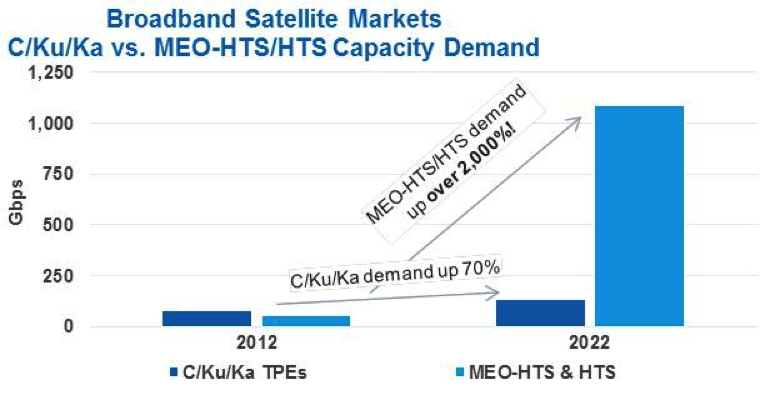HTS/MEO-HTS Capacity Drives New
Markets
Feb 19th, 2014 by
Jose Del Rosario, NSR
One of the biggest concerns in the satellite industry today
is that new HTS and MEO-HTS (i.e. O3b Networks) capacity will
severely undercut existing FSS C- and Ku-band transponder demand
for a gamut of broadband satellite markets. Already numerous
operators are claiming severe price pressure on satellite
capacity in different parts of the world and are linking this to
the arrival of new HTS services. Plus more than one operator is
dreading the day they will need to go head-to-head with O3b for
certain services notably in the backhaul and trunking markets.
To illustrate the impact of HTS/MEO-HTS capacity leasing on
the overall broadband satellite market, NSR has attempted to
compare its recent forecasts in its Broadband Satellite
Markets 12th Edition study for C/Ku/Ka TPE
leasing to HTS/MEO-HTS leasing directly in terms of Gbps of
leased capacity.
The exhibit illustrates that
there will be a real net increase,
about 70%, in Gbps of classic FSS C/Ku/Ka transponder leasing in
the coming ten years
driven by improving technology and greater capacity provisioning
per provisioned site. Most of the new transponder demand growth
will come for Ku-band capacity mainly in the VSAT networking
market such as in government-backed rural connectivity projects
or for high value, mission critical services.
However, this will
be dwarfed by the more than 2,000% gain in HTS and MEO-HTS
leasing in the coming ten years.
Most of the HTS and MEO-HTS capacity demand growth, over 80%,
will be generated by satellite broadband access services, whilst
the remainder will be driven by a mix of trunking, backhaul and
corporate-class VSAT services.
But, it is critical to note that
MEO-HTS and HTS capacity is priced
much lower per Mbps than classic FSS capacity.
This lower pricing is
essential to opening up new markets, such as satellite broadband
access, as well as keep satellite competitive
for the most price sensitive clients
within the enterprise VSAT, trunking and backhaul markets.

Source: NSR
Bottom Line
NSR does not deny that in the
short- to mid-term, there will be some significant competition
between satellite operators and service providers trying to sell
both classic FSS capacity as well as newer HTS and MEO-HTS
capacity to end user clients. These
competitive pressures will no doubt
lead to the perception that classic FSS capacity, at least that
used to serve various broadband satellite services, is under
pressure.
Nonetheless, NSR continues to see
real advantages to classic FSS capacity versus HTS or MEO-HTS
for certain client sets that transcend the pure price per bit
equation. FSS capacity
offers advantages of
larger coverage areas, typically better service quality, the
ability to fully manage the network from end-to-end, and the
flexibility to place hubs and gateways in any convenient
geographical location. It is the clients who value these aspects
of FSS capacity that will generate NSR’s forecasted growth in
FSS transponders for broadband satellite services.
However, other
clients will value higher the lower cost per bit of HTS and
MEO-HTS capacity. And,
in fact, NSR firmly maintains that the existing markets that
were already under pressure from terrestrial services now stand
a real chance of growing simply because classic FSS capacity is
not truly price competitive for these markets. In other words,
the industry was already losing the battle for these clients
regardless of the price pressure the classic FSS capacity was
under. On a net-net basis, NSR maintains the view that
HTS and MEO-HTS capacity will not
replace use of C/Ku/Ka-band transponders, but will instead
compliment and greatly expand the broadband satellite markets
for the industry to operate in.
This is where the industry needs to focus on in order to
succeed.